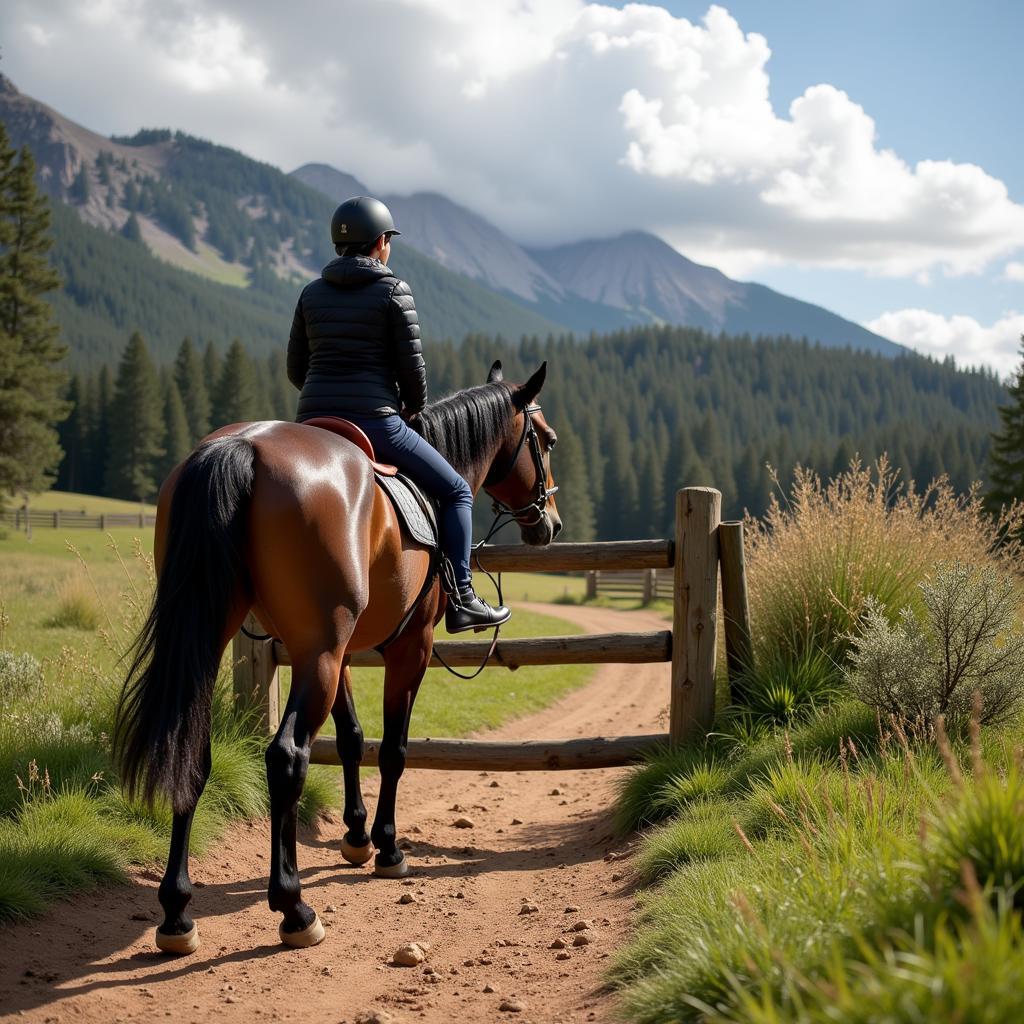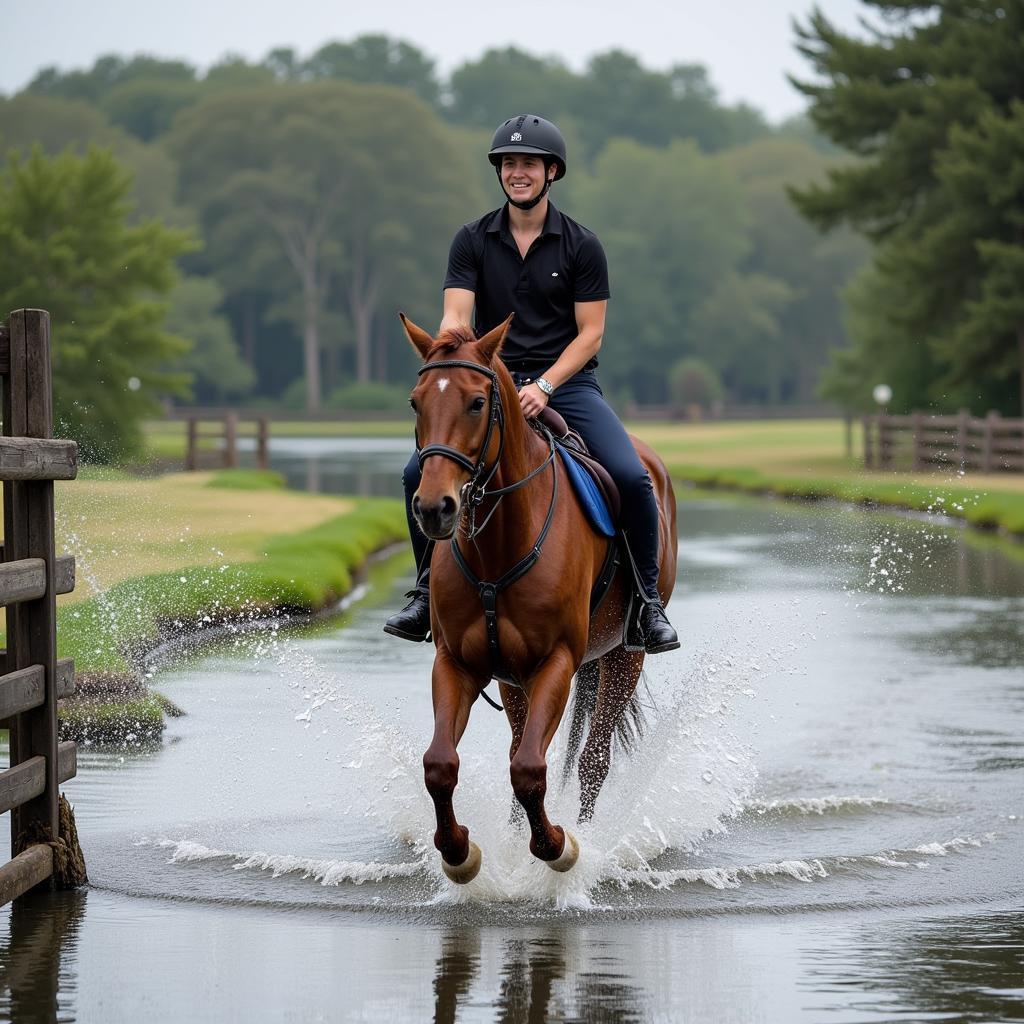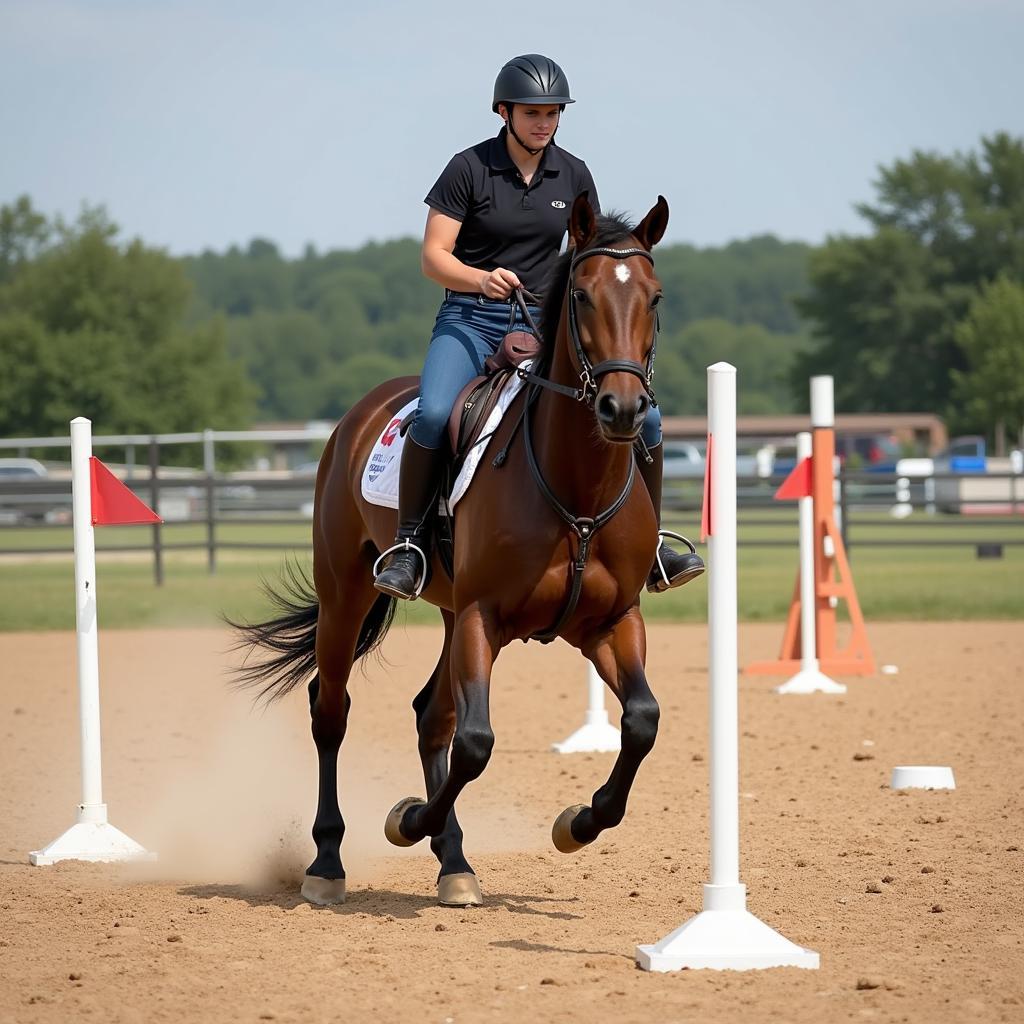Horse trail courses, with their unique blend of natural and man-made obstacles, offer a thrilling challenge for both horse and rider. Navigating these obstacles requires a strong partnership built on trust, communication, and skillful riding. Whether you’re a seasoned competitor or a weekend enthusiast, understanding the intricacies of Horse Trail Course Obstacles is key to a safe and rewarding experience.
 Horse and Rider Approaching Trail Obstacle
Horse and Rider Approaching Trail Obstacle
Decoding the Trail: Types of Horse Trail Course Obstacles
Horse trail course obstacles are designed to test a horse’s athleticism, bravery, and problem-solving skills, while also evaluating the rider’s horsemanship and decision-making abilities. These obstacles can be broadly categorized into:
1. Natural Obstacles: Embracing the Terrain
Natural obstacles utilize the landscape’s inherent features to create challenges. These obstacles often involve:
- Water Crossings: From shallow streams to deeper ponds, water crossings test a horse’s confidence and footing.
- Hills: Steep ascents and descents require balance, strength, and careful weight distribution from both horse and rider.
- Logs and Fallen Trees: Navigating over or through these obstacles requires careful footwork and trust in the horse’s judgment.
- Uneven Terrain: Rocky paths, muddy patches, and varying ground conditions challenge a horse’s surefootedness and adaptability.
 Horse and Rider Crossing Water Obstacle
Horse and Rider Crossing Water Obstacle
2. Man-Made Obstacles: Testing Skill and Versatility
Man-made obstacles introduce elements designed to mimic real-life situations or test specific skills. Common man-made obstacles include:
- Gates: Opening and closing gates from horseback demonstrates control, precision, and the ability to work as a team.
- Bridges: Crossing over bridges of various materials and designs assesses a horse’s confidence and ability to handle different surfaces.
- Poles and Rails: Navigating through poles on the ground encourages focus, precision, and footwork.
- Obstacles with Tarps or Fabric: Encountering unusual textures and movements helps desensitize horses and build their bravery.
 Horse and Rider Navigating Poles on Trail Course
Horse and Rider Navigating Poles on Trail Course
“A well-designed trail course is like a dance between horse and rider,” says renowned trail riding expert, Sarah Williams. “It’s about finding harmony in the challenges, building confidence through successful navigation, and ultimately, strengthening the bond between partners.”
Preparation is Key: Setting Yourself Up for Success
Before tackling any horse trail course, adequate preparation is crucial for both horse and rider.
For the Horse:
- Fitness: Ensure your horse is conditioned to the level of difficulty of the course.
- Training: Familiarize your horse with different types of obstacles through groundwork and gradual desensitization.
- Foot Care: Healthy hooves are essential for navigating uneven terrain and obstacles. Consult with your farrier for appropriate shoeing.
For the Rider:
- Riding Skills: Confident and balanced riding is fundamental.
- Knowledge of Aids: Clear communication through your aids (legs, reins, seat) is essential for guiding your horse.
- Safety Gear: Always wear a properly fitted helmet and consider using safety vests and appropriate footwear.
Approaching Obstacles: A Partnership of Trust and Skill
Approaching any obstacle requires a calm and confident demeanor from the rider. Here’s a breakdown of effective obstacle navigation:
- Assessment: Analyze the obstacle from a distance, identifying the safest and most efficient route.
- Communication: Clearly communicate your intentions to your horse using consistent aids.
- Patience: Allow your horse time to assess the obstacle and find their footing.
- Support: Provide encouragement and support, but avoid interfering with your horse’s natural balance and movement.
Remember, trail riding should be enjoyable for both horse and rider. Choose courses appropriate for your skill level and gradually introduce new challenges. By focusing on clear communication, mutual trust, and a partnership built on respect, you and your horse can conquer any obstacle the trail throws your way.
Frequently Asked Questions About Horse Trail Course Obstacles
1. What should I do if my horse refuses an obstacle?
Never force your horse. Instead, calmly back them away and reassess the situation. Try approaching from a different angle or breaking the obstacle down into smaller steps. If the refusal persists, it may indicate a training or confidence issue that requires further attention.
2. How can I help my horse become braver on the trail?
Building a horse’s confidence takes time and patience. Introduce new obstacles gradually, starting with simple challenges and progressively working up to more complex ones. Positive reinforcement, such as praise and treats, can go a long way in encouraging bravery.
3. What is the best way to prepare for my first horse trail competition?
Practice on a variety of obstacles and familiarize yourself with the rules and scoring system. Consider taking lessons from an experienced trail riding instructor who can provide personalized guidance and help you develop a competitive edge.
Need help choosing the right equipment for your next trail adventure? Check out our articles on poles for horses and the importance of a good quality horse ribbon.
For those curious about competitive trail riding, our article on the Arkansas State Championship Horse Show provides a fascinating glimpse into the world of elite trail riding.
Remember, when it comes to conquering horse trail course obstacles, safety and enjoyment should always come first. By approaching each challenge with a well-prepared horse, confident riding skills, and a focus on partnership, you can experience the thrill and fulfillment of successful trail riding.
If you have any questions or need assistance, please contact our team at Phone Number: 0772127271, Email: [email protected]. You can also visit us at our location: QGM2+WX2, Vị Trung, Vị Thuỷ, Hậu Giang, Việt Nam. We have a 24/7 customer service team to assist you.